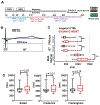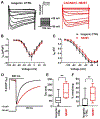Patient-independent human induced pluripotent stem cell model: A new tool for rapid determination of genetic variant pathogenicity in long QT syndrome
- PMID: 31004778
- PMCID: PMC6935564
- DOI: 10.1016/j.hrthm.2019.04.031
Patient-independent human induced pluripotent stem cell model: A new tool for rapid determination of genetic variant pathogenicity in long QT syndrome
Abstract
Background: Commercial genetic testing for long QT syndrome (LQTS) has rapidly expanded, but the inability to accurately predict whether a rare variant is pathogenic has limited its clinical benefit. Novel missense variants are routinely reported as variant of unknown significance (VUS) and cannot be used to screen family members at risk for sudden cardiac death. Better approaches to determine the pathogenicity of VUS are needed.
Objective: The purpose of this study was to rapidly determine the pathogenicity of a CACNA1C variant reported by commercial genetic testing as a VUS using a patient-independent human induced pluripotent stem cell (hiPSC) model.
Methods: Using CRISPR/Cas9 genome editing, CACNA1C-p.N639T was introduced into a previously established hiPSC from an unrelated healthy volunteer, thereby generating a patient-independent hiPSC model. Three independent heterozygous N639T hiPSC lines were generated and differentiated into cardiomyocytes (CM). Electrophysiological properties of N639T hiPSC-CM were compared to those of isogenic and population control hiPSC-CM by measuring the extracellular field potential (EFP) of 96-well hiPSC-CM monolayers and by patch clamp.
Results: Significant EFP prolongation was observed only in optically stimulated but not in spontaneously beating N639T hiPSC-CM. Patch-clamp studies revealed that N639T prolonged the ventricular action potential by slowing voltage-dependent inactivation of CaV1.2 currents. Heterologous expression studies confirmed the effect of N639T on CaV1.2 inactivation.
Conclusion: The patient-independent hiPSC model enabled rapid generation of functional data to support reclassification of a CACNA1C VUS to likely pathogenic, thereby establishing a novel LQTS type 8 mutation. Furthermore, our results indicate the importance of controlling beating rates to evaluate the functional significance of LQTS VUS in high-throughput hiPSC-CM assays.
Keywords: Action potential; Extracellular field potential; Human induced pluripotent stem cells; L-type Ca current; Long QT syndrome type 8.
Copyright © 2019 Heart Rhythm Society. Published by Elsevier Inc. All rights reserved.
Conflict of interest statement
There are no relationships with industry. The authors declare no financial conflict of interest.
Figures







Comment in
-
Patient-independent iPS cells and modeling long QT syndrome.Heart Rhythm. 2019 Nov;16(11):1696-1697. doi: 10.1016/j.hrthm.2019.05.027. Epub 2019 May 28. Heart Rhythm. 2019. PMID: 31150820 No abstract available.
References
-
- Tester DJ and Ackerman MJ. Sudden infant death syndrome: how significant are the cardiac channelopathies? Cardiovasc Res. 2005;67:388–96. - PubMed
-
- Knollmann BC and Roden DM. A genetic framework for improving arrhythmia therapy. Nature. 2008;451:929–36. - PubMed
-
- Priori SG, Wilde AA, Horie M, Cho Y, Behr ER, Berul C, Blom N, Brugada J, Chiang CE, Huikuri H, Kannankeril P, Krahn A, Leenhardt A, Moss A, Schwartz PJ, Shimizu W, Tomaselli G and Tracy C. HRS/EHRA/APHRS expert consensus statement on the diagnosis and management of patients with inherited primary arrhythmia syndromes: document endorsed by HRS, EHRA, and APHRS in May 2013 and by ACCF, AHA, PACES, and AEPC in June 2013. Heart rhythm : the official journal of the Heart Rhythm Society. 2013;10:1932–63. - PubMed
-
- Richards S, Aziz N, Bale S, Bick D, Das S, Gastier-Foster J, Grody WW, Hegde M, Lyon E, Spector E, Voelkerding K, Rehm HL and Committee ALQA. Standards and guidelines for the interpretation of sequence variants: a joint consensus recommendation of the American College of Medical Genetics and Genomics and the Association for Molecular Pathology. Genet Med. 2015;17:405–24. - PMC - PubMed
-
- Ackerman MJ. Genetic purgatory and the cardiac channelopathies: Exposing the variants of uncertain/unknown significance issue. Heart Rhythm. 2015;12:2325–31. - PubMed
Publication types
MeSH terms
Substances
Grants and funding
LinkOut - more resources
Full Text Sources

